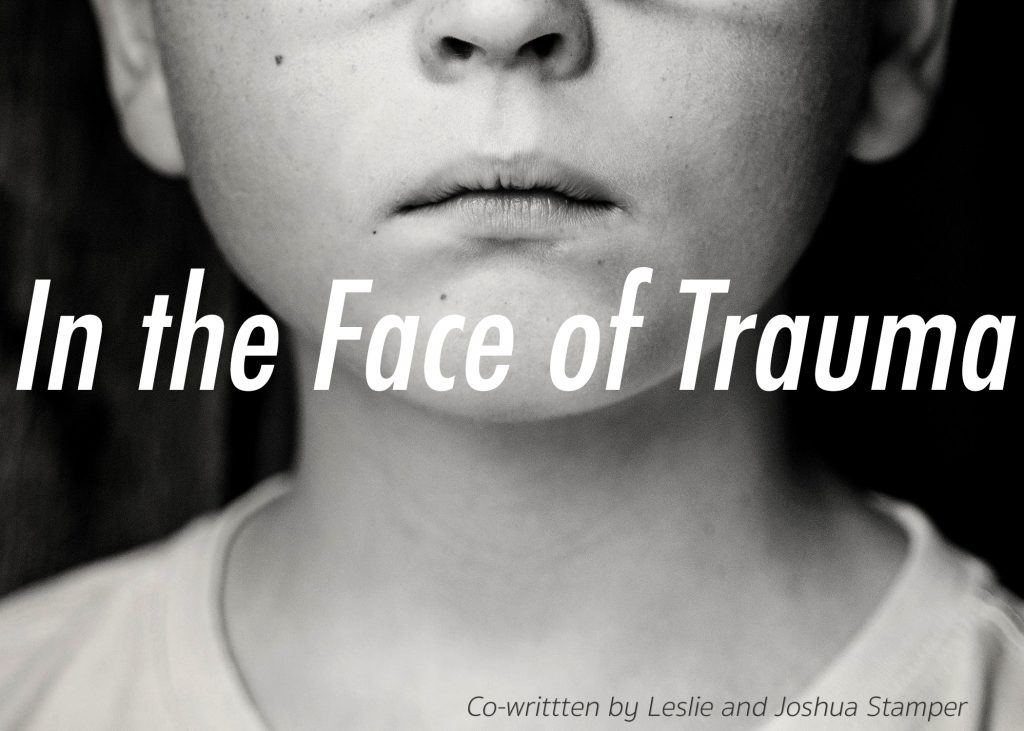In the Face of Trauma

My wife, Leslie, and I were foster parents for 5 years. During those years, we had a couple foster placements who were able to be reunified with their family, and three of our five children were adopted from foster care. I invited my wife to join me on this blog post to add her voice and perspective to the necessary awareness of meeting the educational and emotional needs of children who have been impacted by trauma.
A few weeks ago, 60 Minutes had a segment on the impact of trauma on children. An increasing amount of research, literature and media around trauma-informed care, trauma-informed classroom management, Trust-Based Relational Intervention (TBRI) and Adverse Childhood Experiences surveys (ACEs) has been made available to the public and incorporated into mainstream practices in pediatricians offices and school classrooms over recent years.
We’ve implemented trauma-informed care in our home for years, starting when we first became licensed as foster parents. Trauma-informed or TBRI-based training is mandatory annually for foster homes in Texas, and the implementation of what we learned required a shift in how I (Leslie) parent, as well as how I think about children when they are acting out. Where I once would see a behavior or outburst from my kids as something to immediately stop and correct through discipline, I now look for the reason behind the behavior. It’s similar to when, as a new parent, I closely monitored my kids’ sleep and eating. I would expect tantrums or arguments when they missed a nap or hadn’t eaten in a while. I would respond differently if I could find a reason behind the outburst, if the negative behavior was “justified” by a physical need. Or when they were showing signs of sickness, I would have expected shortened tempers and increased emotional needs. Now, in addition to considering their health, sleep, nutrition and hydration, I also keep in mind the past trauma my adopted children have endured, and evaluate their needs or behaviors from the lens of – what happened in the past? Could there be a trigger or a memory that has been activated, causing my children to react in fight, flight or freeze behaviors?
There is a story they used in our training classes to help new foster parents understand the impact of triggers and suppressed memories. A young foster child would frequently have dramatic tantrums in the car. Thrashing, screaming, crying, and they seemed to come on rapidly and without warning. There was a trigger there, but the foster parents couldn’t identify it. They were encouraged by a trauma-informed behavior therapist to start taking notes on when these outbursts would occur, and the foster family found a pattern – it always started on a road they drove frequently in their town, next to an apartment complex. When relaying this information to the CPS case worker, the case worker was able to clarify that the apartment complex looked similar to the girl’s place of removal where some terrible abuse had occurred. The girl was a toddler, too young to explain any of this, but still she remembered.
Trauma memories can be triggered by a sight or smell or sound or touch. These moments of reactivity, though challenging to navigate and embarrassing in public, are an opportunity to learn more about my child and meet a need that had not been met in their developmental history. It allows me to first respond with connection before discipline or correction. It’s an opportunity to step in and partner in the healing process.
(The brain scan shown above indicates the effects of trauma at an early developmental age, which will impact the child’s regulation of emotions and cognitive level.)
Until recently, my adopted children have been primarily at home where we could address these developmental traumas in the safety of a parenting unit that has been trained in trauma-informed care. We have just recently stepped into the stage of sending our adopted children into the world to be cared for by other adults, primarily their classroom teachers. This is a scary place to be, and I worry that they will be misunderstood, that an unwanted or unacceptable behavior will be addressed in a way that stops that behavior but disregards the need that is being expressed. For this reason, I am encouraged by the increased publicity and research around trauma-informed care and want to encourage you, as educators investing in your classrooms and schools, to take pause when dealing with negative behaviors on your campus. To look at the child and consider:
- Why are they acting this way?
- What are they reacting to?
- What is their need?
- How can I connect with them in this moment before correcting the behavior?
As an administrator, I (Joshua) have experienced a great deal of negative student behavior and have seen an increase of students who have a very difficult time regulating their emotions and responding rationally in stressful situations. We all learn the importance of Maslow’s hierarchy of needs but rarely do we discuss how to assist in student mental and emotional health. As the Ohio Department of Education states (see graphic below), the brain of a child who has been exposed to trauma at an early age develops quite differently. Prior to my experience to foster care, my understanding of the results of trauma was nonexistent. Our TBRI-based training helped me understand that the brain is trained to survive dangerous situations and changes the function of the neurological system in times of hardship or stress. After repeated experiences of trauma, the brain will cope with distressing events by operating at a primal level, which is the fight, flight or freeze functions.
It’s easy to assume that each child comes from a good situation at home but, unfortunately, many children have been exposed to or are living through horrific situations. When interacting with students you don’t know or have an established relationship with, use the following techniques to assist in student management to develop trust and a positive relationship.
Low tone and volume of voice
The tone and volume of your voice can drastically change the dynamics of a interaction. In a typically developed brain, raising your voice may get the attention of a child but in a trauma developed brain, raising your voice is a sign of danger. In all interactions, utilize a low and controlled tone of voice to provide a calm response to student behavior. The goal should always be to deescalate the situation instead of releasing our own emotions, which may include anger and frustration.
Proximity to the student
It is quite natural to correct a students behavior by using close proximity. However, when communicating to a student who has experienced trauma, it is important to make sure you don’t get too close or move too quickly toward the child. We need to be mindful of our non-verbals and our spacial awareness to disarm fear. Getting too close to a student in a fight or flight situation will only increase the survival response. In addition to proximity of space, we need to be mindful of proximity of height. Instead of standing over a student during an interaction, which may scare or intimidate the child, try to get down to the same level as the student. Bending down, taking a seat or keeling allows a child to feel safe and empowered in the situation.
Avoid Power Struggles
Students who have experienced trauma have a redefined perception of safety, danger cues and trust, which will lead to seeking control of other situations (see below). It is important to understand that the child is trying to protect themselves and their behavior is a direct reflection of this fear. Many times, as I am in hurry or I am being pulled in many directions, I fall into the trap of thinking “I am the adult” or “they just need to do what I tell them” but it’s very important to take the time to meet the student at their own needs. Avoid disempowering the student through clear expectations, respectful communication, and consistent actions.
Historically, schools operate on a punitive level for student behavior, which ignored finding a solution for students’ mental health and often caused further trauma. Thankfully, many schools are now finding ways to incorporate restorative practices and social/emotional learning in the classrooms. It is imperative we continue to focus on connecting and empowering our students by modeling, facilitating and developing positive relationships. As educators, it is our responsibility to explore alternative strategies to break the cycle of trauma instead of relying on traditional approaches. Students won’t be able to grow academically or see their full potential until they consistently feel safe, respected and loved.
Other Trauma Informed books and resources:
“The Boy who was Raised as a Dog: And Other Stories from a Child Psychiatrist’s Notebook – What Traumatized Children Can Teach Us about Loss, Love and Healing” by Dr. Bruce Perry
“The Mystery of Risk: Drugs, Alcohol, Pregnancy, and the Vulnerable Child” by Ira Chasnoff MD
“Lost at School” by Ross Greene PhD
The 60 Minutes interview can be found at: https://www.cbsnews.com/news/oprah-winfrey-treating-childhood-trauma/
Ted Talk on the impact of childhood trauma on health (ACEs): https://www.ted.com/talks/nadine_burke_harris_how_childhood_trauma_affects_health_across_a_lifetime
Trust-Based Relational Intervention resources: https://child.tcu.edu/about-us/tbri/#sthash.PZBmMmvo.dpbs
In this blog series, Leslie and Joshua Stamper have taken a deeper look at essential aspects of trauma informed practices, Trust Based Relationship Interventions, and Restorative Practices from the perspective of a parent and a school administrator. You can find more posts on trauma at The Language of Behavior and History of Trauma.


